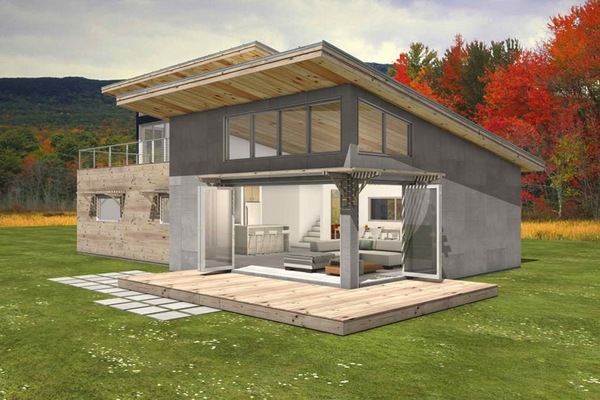Table Of Content

The thermal mass retains the heat and is able to increase the room’s ambient temperature for long periods of time, much like a stone or brick fireplace. Passive solar design refers to smart systems built without any moving parts or electrical components (i.e. passive systems). With this in mind, buildings with intentional passive solar systems are meant to work incredibly simply, without much effort or upkeep required from building owners.
Passive Solar Heating
The building is constructed east-to-west and also uses indirect passive solar heating throughout the concrete walls. On the other hand, active solar design refers to the installation of either gas or electric solar energy components such as photovoltaic solar panels or thermal solar heating systems. The goal of a passive solar design is to convert sunlight into ambient heat in a building or home. This is known as solar gain, which can be used to heat a building’s internal air, water supply, or thermal mass. Most commonly, this is achieved by letting sunlight hit the proposed area through windows, skylights, and open concepts. The use of natural convection air currents (rather than mechanical devices such as fans) to circulate air is related, though not strictly solar design.
How to Install Passive Solar Design
Overhangs and canopies provide shade during the summer while letting sunlight penetrate the deep interior during the winter. An extensive storm water retention system, geothermal heating and cooling, super insulation and air-sealing, and Passive House quality triple-pane windows ensure the home’s long-term efficiency and comfort. In addition, The Guide to Energy Savings E-book includes a 3-page directory of even more resources related to home solar energy systems and energy efficiency.
Radiative heat transfer
In a conventional home, the window area is equally distributed on all four sides of the home, or the majority of the window area may be focused on the direction with the best view. For a passive solar design, one would locate more of the window area on the south side, which has the best solar access. Some windows would be placed on the east and west sides of the house for daylighting and cross-ventilation with only a few windows to the north. Energy-efficient landscaping materials for careful passive solar choices include hardscape building material and "softscape" plants. The use of landscape design principles for selection of trees, hedges, and trellis-pergola features with vines; all can be used to create summer shading.
By leaving openings above the east-west partitions, we were able to assure that air rising to the ceiling of the sun room will move back into the northern parts of our house. Of course, a room — like a bottle — can take in new air only if there’s a way for the old to escape. Therefore, to allow the cooler, heavier air to get out, we made a vent in the floor along the entire north wall. That cooler (but still warm) air falls beneath the floor and moves back to the south, passing under our feet. A vent running the length of the south wall completes the circulation pattern. The house I designed for them is a three-bedroom, 1,850-square-foot home located in the foothills of the Sierra Nevada Mountains of California, a climate with hot summers and some snow in winter.
The reason is that once energy has entered your home (as in light through the window), it’s in. It will then either be absorbed by the floor, or reflected by the floor, in which case it will then hit another surface in your home and the heat will be partially absorbed there. Some light will be reflected towards and out the window again, but you are pretty much splitting hairs at that point.
Making an old home healthier for you and the environment - CNN
Making an old home healthier for you and the environment.
Posted: Tue, 18 Jun 2019 07:00:00 GMT [source]
How To Properly Evaluate Solar Panel Companies
When working with the experts, make sure to communicate your ideas for materials, positioning of objects and surfaces, and how you want the heat distributed. When planning your passive solar home, you also need to focus on how the heat will be distributed throughout your house. Once the inside of your home starts to heat up from the sun, the heat will disperse to different areas from its source through either conduction, convection, or radiation. I am am new to this site, but I'm starting to see that there are really great topics, articles and discussions going on here.
this earth day, designboom revisits the year's top examples of passive architecture
This paper highlights the importance of power tolerance when choosing solar panels. Homeowners demand a lot from the solar panels they select for their rooftop system. Yes, you can successfully install solar panels on the flat roof of your home or business....
Overheating of the building interior can result with insufficient or poorly designed thermal mass. About one-half to two-thirds of the interior surface area of the floors, walls and ceilings must be constructed of thermal storage materials. Thermal mass in floors and walls should be kept as bare as is functionally and aesthetically possible; thermal mass needs to be exposed to direct sunlight.
This "convective rain" is more commonplace in southern Florida, where the sun is more intense. In a climate like New England where night time temperatures are generally lower than daytime ones, focus on bringing in cool nighttime air and then closing the house to hot outside air during the day. Mechanical ventilation is one way of bringing in cool air at night, but convective cooling is another option. Wyant Architecture in collaboration with Hanson Fine Building has designed this passive solar house nestled on a wooded 1.5-acre property in Wallingford, Pennsylvania.
As the demand for sustainable housing continues to grow, so too will the innovation and creativity driving this transformative movement toward a more sustainable and harmonious built environment. Staffed mostly by Navajo workers, ZenniHome has a goal for its factory to become the highest-producing housing factory in the world. When expansion is completed by the end of 2025, the factory is expected to produce up to 25 homes a day. ZenniHome is currently already producing homes; earlier this month, nine units were delivered to Los Milics Vineyards near Tucson, Arizona. Integrating smart home technologies into sustainable housing allows for greater control and optimization of energy usage. By opting for materials that are renewable, nontoxic and locally sourced, homeowners can reduce the carbon footprint of their construction projects while promoting a healthier indoor environment free from harmful chemicals.
Each has an automatic INSTALL routine or a READ.ME file explaining how to use it. You are welcome to publish the output and share copies provided that the Regents Copyright and Terms of Use remain unaltered. A diverse digital database that acts as a valuable guide in gaining insight and information about a product directly from the manufacturer, and serves as a rich reference point in developing a project or scheme. Lowe consistently recommends smart thermostat controls to her clients and new homeowners alike. “You’ll be able to adjust your temperature settings when you’re away, and some smart thermostats track your energy consumption so you stay on track,” adds Rodriguez. Companies that specialize in toxin-free cabinets include Puustelli Kitchens, Bertolini, KERF, PureKitchen, and more.
Creating energy-efficient buildings has increasingly become a delicate balance, where designing features that decrease the energy needed can actually increase the energy-intensive materials required to build them. The foundation of thehouse consists of two concrete slabs, 36'x36',with concrete block pillars supporting the subfloor. First, the 100 year floodplane is about 4' above grade at the house site, and code requires (wisely) that the first floor be above that level. Once the house has to be up 4', one might as well raise it a few more feet, and make usable space below the house.

















